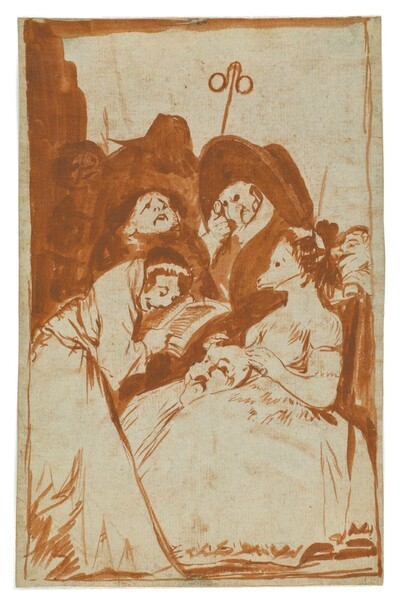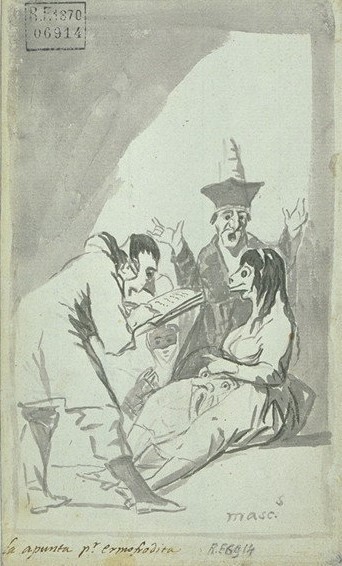- Cronología
- Ca. 1796 - 1797
- Ubicación
- The Prado National Museum. Madrid, Madrid, Spain
- Dimensiones
- 293 x 187 mm
- Técnica y soporte
- Reconocimiento de la autoría de Goya
- Documented work
- Titular
- El Prado National Museum
- Ficha: realización/revisión
- 14 Sep 2022 / 23 Jun 2023
- Inventario
- D4201
11 (in pencil; recto, top centre)
108 (in ink; recto, upper right-hand corner)
50 (in pencil; recto, lower left-hand corner)
Mascaras de caricaturas / qe apuntaron pr. su significado (in pencil; recto, lower centre)
Stamp of the Prado Museum (stamped; reverse, lower right)
30 (reverse, upper left-hand corner)
Watermark: H C WEND / & / / ZOONEN
On the gestation, history and aims of the series known as Dreams, a set of preparatory drawings for The Caprices, see Dream 1: Universal Language.
Line of provenance of the present drawing: Javier Goya; Mariano Goya, 1854; Valentín Carderera, ca. 1861; Mariano Carderera, 1880; Prado Museum, 1886.
A scene that develops an idea already raised in the Notebook B in The aim by hermaphrodite (B. 59) and which will serve as a preparatory drawing for Caprice 57, Filiation. Matilla talks about how the work deals with relationships between men and women, characterised by lies or abuse. In this scene, Goya's social criticism is perfectly evident. It depicts a man standing reading to a woman, both wearing masks. Another man, also wearing a mask, observes them with a magnifying glass and carries a primate on his shoulders that stares at the viewer. The scene points to a carnivalesque satire on marriage and the sexual identity of the bride and groom, the bride (as a hermaphrodite) holding a double-sex mask in her lap.
Matilla believes that the arrangement of the engraving does not correspond exactly to that of the preparatory drawing, as the man reading is replaced by a woman, behind whom, instead of a figure, there are two figures wearing a different hat from the original composition. And the monkey disappears from the scene. There are marks of the print of the sheet on the upper part of the paper and traces of folding in the corners, which suggest that the sheet was folded when it passed through the press.
There are also traces of rubbed sanguine on the back of the sheet, an operation to facilitate the transfer of the image onto the sheet by the effect of the lines of the drawing. It is possible that the rubbing of the sanguine on some parts of the image corresponds to tracing by pressure.
-
Goya. La década de Los CaprichosMadrid1992organized by Real Academia de Bellas Artes de San Fernando sponsored by Fundación Central Hispano, Madrid, consultant editor Nigel Glendinnig. From October 26th 1992 to January 10th 1993cat. 41
-
Goya: Prophet der ModerneAlte NationalgalerieBerlin2005from July 13th to October 3th 2005. Exhibitied also at the Kunsthistorischemuseum, Vienna, October 18th 2005 to January 8th 2006, consultant editor Manuela B. Mena Marquéscat. 63
-
Madrid2019cat. 52
-
Los Caprichos de Goya y sus dibujos preparatoriosBarcelonaInstituto Amatller de Arte Hispánico1949p. 93
-
Goya’s Caprichos. Beauty, Reason and CaricatureNueva JerseyPrinceton University Press1953p. 204, fig. 45
-
MadridMuseo del Prado1954n. 56
-
Vie et ouvre de Francisco de GoyaParísOffice du livre1970p. 186, nº 624
-
Dibujos de Goya, 2 volsBarcelonaNoguer1975p. 87
-
MadridSilex1980pp. 74-75, nº 12
-
MadridReal Academia de Bellas Artes de San Fernando1992p. 67, n. 41
-
El sueño dibujadoActas de las I Jornadas de arte en Fuendetodos. Realidad y sueño en los viajes de GoyaZaragozaDiputación de Zaragoza1996p. 53, fig. 16
-
MadridMuseo Nacional del Prado1999p. 299
-
Dumont2005p. 187
-
MadridMuseo Nacional del Prado2019p. 121



